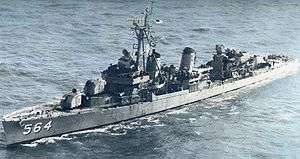
USS Rowe (DD-564)
USS Rowe (DD-564) was a Fletcher-class destroyer of the United States Navy, named for Lieutenant John Rowe, who served with Lt. Stephen Decatur during the First Barbary War.
Rowe was laid down 7 December 1942 by the Seattle-Tacoma Shipbuilding Co., Seattle, Wash.; launched 30 September 1943; sponsored by Mrs. Louise Bradley Roberson; and commissioned 13 March 1944, Commander A. L. Young, Jr., in command.
World War II
Following shakedown off San Diego, Rowe got underway for Pearl Harbor 24 May 1944. After 2 weeks of additional underway training in the Hawaiian Islands, she completed a round-trip escort run to Eniwetok, 16 June to 2 July, and on 3 August 1944 sailed as flagship of Destroyer Squadron 57 (DesRon 57) for Adak, Alaska, to report for duty with the 9th Fleet. She engaged in underway training there, and participated in three strikes against the Kurils; Matsuwa To Island on 21 November 1944, Suribati Wan on 3 January 1945, and Kurabu Zaki, Paramushiro Island on 18 February 1945. On 18 April, Destroyer Division 113 (DesDiv 113) was detached from the North Pacific Force and sailed for Pearl Harbor.

Château d'Ussé
The Château d'Ussé is located in the commune of Rigny-Ussé in the Indre-et-Loire département, in France. The stronghold at the edge of the Chinon forest overlooking the Indre Valley was first fortified in the eleventh century by the Norman seigneur of Ussé, Gueldin de Saumur, who surrounded the fort with a palisade on a high terrace. The site passed to the Comte de Blois, who rebuilt in stone.
In the fifteenth century, the ruined castle of Ussé was purchased by Jean V de Bueil, a captain-general of Charles VII who became seigneur of Ussé in 1431 and began rebuilding it in the 1440s; his son Antoine de Bueil married in 1462 Jeanne de Valois, the biological daughter of Charles VII and Agnès Sorel, who brought as dowry 40000 golden écus. Antoine was heavily in debt and in 1455, sold the château to Jacques d’Espinay, son of a chamberlain to the Duke of Brittany and himself chamberlain to the king; Espinay built the chapel, completed by his son Charles in 1612, in which the Flamboyant Gothic style is mixed with new Renaissance motifs, and began the process of rebuilding the fifteenth-century château that resulted in the sixteenth-seventeenth century aspect of the structure to be seen today.
USS
USS may refer to:
Organizations:
In computing:
USS may also refer to:

Ubiquitous Synergy Seeker
HIDDEN ERROR: Usage of "management" is not recognized
USS (Ubiquitous Synergy Seeker) is a Canadian alternative dance musical duo that began working out of Parkdale, a neighbourhood situated in the west end of Toronto, Ontario, Canada. The band is composed of vocalist, guitarist, and erhu player Ashley Buchholz (aka Ash Boo-Schultz) and turntablist/hype man Jason "Human Kebab" Parsons.
The USS sound is a mixture of drum and bass beats, grunge-like guitar riffs, and 2-step rhythms. "We like to call what we do the campfire after-party," Ash said, "It's like you're at Nirvana Unplugged but there's a drum and bass party and glow sticks all around you."
History
USS hails from the Greater Toronto Area, Ash being from the city of Markham and Kebab from the adjacent town of Stouffville. They met in 2004, while stocking the beer fridge and discussing music when they worked at a golf course; the pair hit it off instantaneously. A couple of months later, Ash's sister was looking for someone to DJ at her upcoming wedding and Human Kebab was suggested for the job. "It was love at first scratch" Ash said, who later moved into Kebab's parents' basement to begin experimenting musically.
Rowe
Rowe may refer to:
People
Places
Other
See also

Rowe, Massachusetts
Rowe is a town in Franklin County, Massachusetts, United States. The population was 393 at the 2010 census. It is part of the Springfield, Massachusetts Metropolitan Statistical Area.
History
Rowe was the site of fishing and foraging for local Native American tribes. The area was first visited by white settlers in 1744, and was the site of a fort to guard against raids. In 1762, the town lands were purchased by the Rev. Cornelius Jones, who named it "Myrifield" after the Greek word for "thousand". The town had enough settlers by 1785 to have it incorporated as a town, renamed by the Massachusetts General Court after John Rowe, a prominent Boston merchant.
The town of Rowe grew around mills on the river, but also had other industries, including sulfur, talc and soapstone mining. This was nowhere more evident than in the now abandoned settlement at the Davis Mine. In the late 1880s, with the addition of the railroad along the river, the area had become somewhat of a small resort town. But, by the advent of the 1900s, most industry had begun to dry up, leaving the town fairly rural until the 1950s. At that point, with the "baby boom" underway, Rowe became the site of Yankee Rowe Nuclear Power Station, the first nuclear power plant in New England, near the Sherman Dam along the Vermont border. The plant was in operation from 1960 to 1992, and the plant is now completely decommissioned, with the nuclear waste set to be transported to Yucca Mountain's containment facilities upon their completion in 2020.
Rowe (surname)
Rowe is a common surname; it has also been used as the name for several places. It is of English origin.
Surname
A–L
Podcasts:

